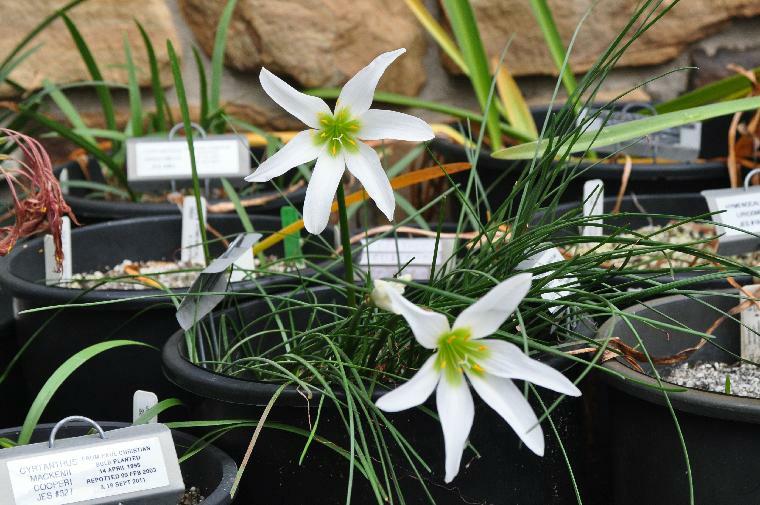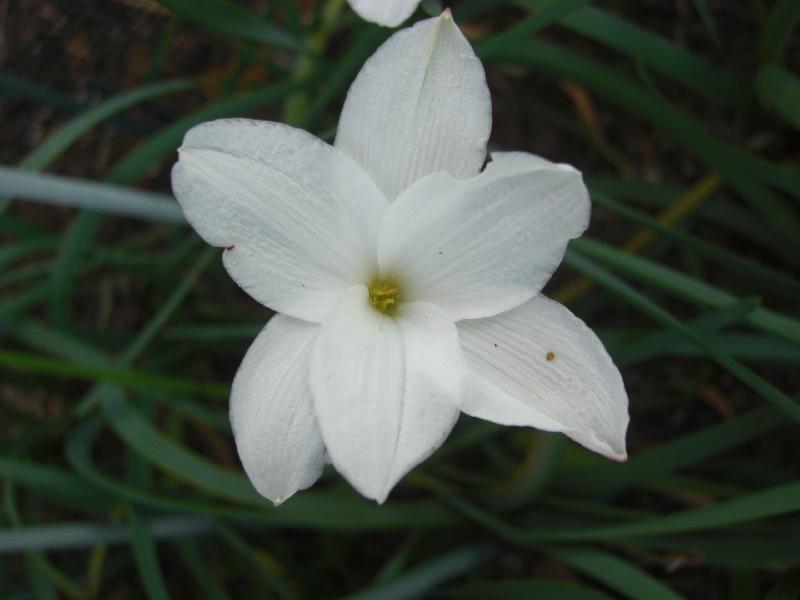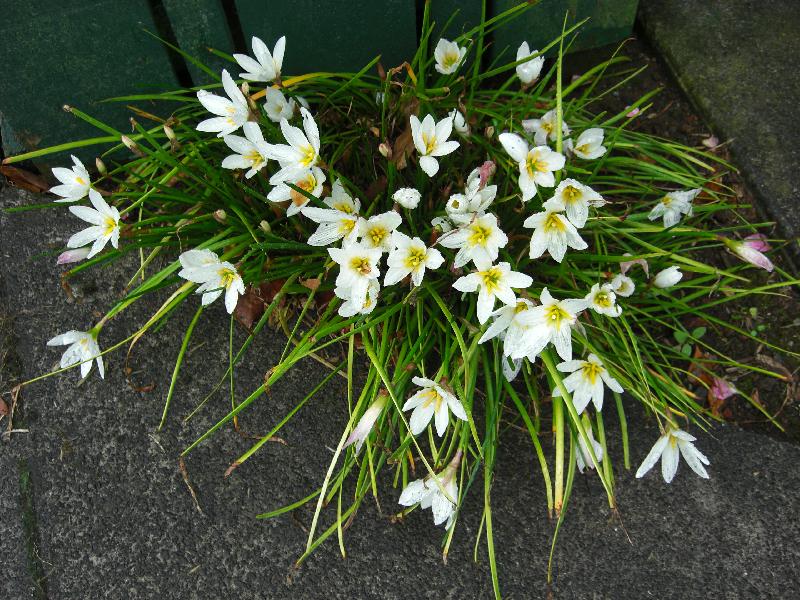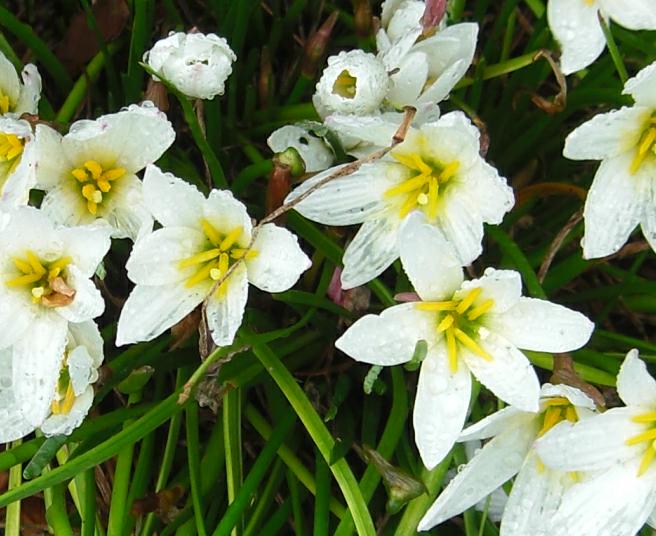White Rain Lilies
White flowered rain lilies occurring in the U.S.A.
Zephyranthes atamasca (or atamasco) has bright green leaves up to 8 mm (1/3 inch) wide. The flowers are funnel shaped and white, sometimes with pink tinge or veins. The tepals (i.e., petals and sepals) are usually reflexed. The floral tube is green and 1 – 2 cm long, no more than ¼ the perianth length and only about ½ the filament length. The filaments are all the same length. The style extends at least 2 mm (ca. 1/10 inch) beyond the anthers. Pedicel length is variable, sometimes absent. The spathe is about 2 to 3 cm long.
It flowers in mid-winter to spring in habitat, and ranges from Mississippi and Alabama to Virginia and Maryland. It tends to grow in moist areas. I water and feed it heavily in late winter through summer, then water it only moderately in autumn and early winter.

Zephyranthes atamasca
Note the trifid stigma extending somewhat beyond the anthers.
Z. atamasca can be distinguished from simpsonii by the length of the style, as the stigma is at the level of or below the anthers
in simpsonii but at least slightly above the anthers in atamasca and ssp. treatiae. In simpsonii the floral tube is 1/3 or more the length of the perianth; in atamasca, the tube is 1/4 or less the length of the perianth. All these species have the stigma trifid (3-lobed). Z. candida is also white and naturalized in this region, but it has a capitate stigma – one rounded knob, not three parts or lobes. All of the white flowered species found in the U.S.A. can have pink coloration or be completely pinkish, and this becomes more pronounced as the flower ages.
Another white species found in the same general region is drummondii, which flowers in summer. The tepals are usually not reflexed. The flower is funnel shaped and 6 - 9 cm across. It has the stigma, which is trifid, down in the floral tube. The floral tube is white to green and 3 - 4 cm long. The filaments are of different lengths. Z. drummondii occurs in Mexico and Texas and may be natural or introduced in the Southeastern States. The leaves of drummondii are distinctly wide, up to 8 mm across, and glaucous, having a gray-green color.
Z. atamasca has 2n=24 chromosomes as does its subspecies treatiae. Z. simpsonii has 2n=48. In the greenhouse, both species readily produce seeds when hand-pollinated. Z. drummondii can have 2n=48 or 72; it is abundantly fertile, producing seeds apomictically. Z. candida has 2n=38 and the forms in cultivation or escaped from cultivation are often sterile; fertile populations of candida are reported in the wild in the native habitat.
Zephyranthes chlorosolen is native to Mexico and Texas, extending northward into Oklahoma and even Kansas. The plant and flower are noticeably smaller than Z. drummondii. Z. chlorosolen is separated from the other white species in the U.S.A. by its long floral tube. The floral tube is longer than the spathe and longer than the filaments. The stigma is capitate (a single knob) and is held at the same level as the anthers. Z. chlorosolen has 2n=48, 60, 68, or 72 chromosomes. The leaves are dull green and about 5 mm (less than ¼ inch) wide.
Z. candida is native to South America but has been introduced widely into the U.S.A. from Texas to Florida and up into North Carolina. The rounded flower is 3 - 4 cm across and occurs in summer to autumn. The tepals are never reflexed. The stigma is capitate (a single knob) and occurs at about the same level as the anthers. The leaves are narrow, only 3 mm (1/8 inch) wide and glossy dark green. If you line up chlorosolen, candida, and drummondii side by side, they are easily told apart by their leaves alone, even if not in bloom. When you set out to identify a rain lily, you need to consider the leaves as much as you consider the flowers.
Z. chlorosolen, Z. drummondii, and Z. candida seem to be pass-along plants, common in gardens and easily shared in parts of the country where they can grow. Even in Indiana, Z. drummondii self-seeds in my larger pots, especially with lantana and Chinese hibiscus trees, which winter over inside a greenhouse. For the first-time grower of rain lilies, I recommend Zephyranthes drummondii very highly; it gets plenty of water and sunshine in summer and a little water regularly in winter.
A much less well-known white species from the U.S.A. is Zephyranthes traubii. It is found in Coastal Texas. This white flower has a capitate (single knob) stigma that extends slightly above the anthers. The flower is salverform (dinner-plate like, atop a narrow tube). The leaves are narrow, almost thread-like at 1 mm wide. I am just starting to grow this species, from seeds; I haven't seen it bloom yet myself. 2n=24. This species differs from Z. chlorosolen in flowering from a smaller bulb but producing a larger flower, and the traubii flower opens flatter. Z. traubii also has narrower leaves than chlorosolen.
I have to admit that I have long considered Z. chlorosolen and Z. drummondii to be so commonplace that I have not bothered to take any pictures of them in the last 20 years or more. I think I will have to work on my gallery of rain lily pictures in the coming years.

Copyright by Ina Crossley. Reproduced by permission.
Zephyranthes drummondii, from Ina Crossley.
Note that stigma is not visible.

Copyright by Ina Crossley. Reproduced by permission.
Zephyranthes candida, from Ina Crossley.

Copyright by Ina Crossley. Reproduced by permission.
Zephyranthes candida close up, from Ina Crossley.
Note the capitate stigma clearly visible above the anthers.
Good sources for information on rain lilies, which I have drawn heavily upon, are these:
- R. Flagg, G. Smith, and W. Flory, "Flora of North America," vol. 26, pp. 281-282 and 296-303 (2002).
- T. M. Howard, "Bulbs for Warm Climates," University of Texas Press (2001).
- Pacific Bulb Society's Images Wiki
Good gardening, from here in central Indiana
Jim
<shieldsgardens@gmail.com>
Look up technical terms in the Glossary of Plant Biology